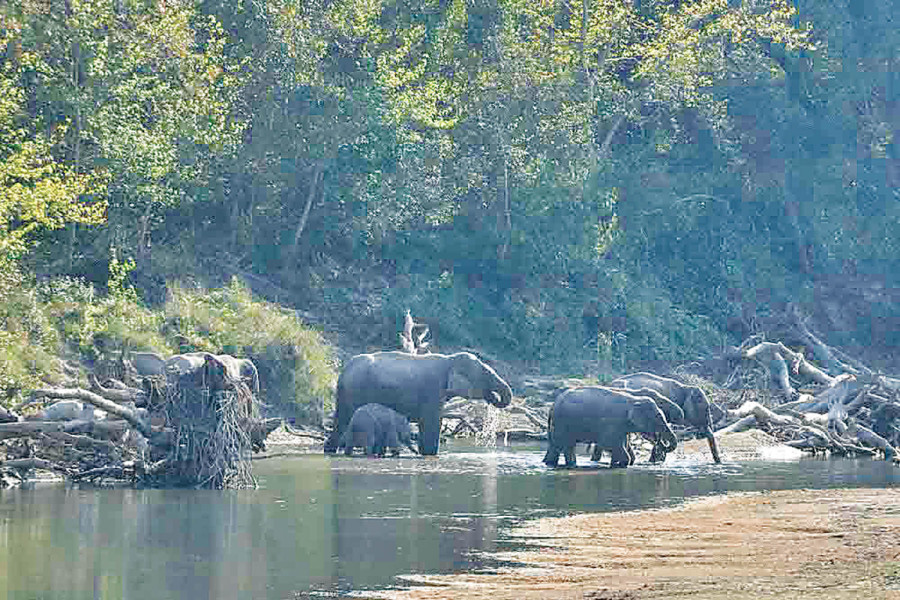Lumbini Province
Bardiya marks World Elephant Day amid growing human-wildlife conflict
Three tiers of government should coordinate to prevent the conflict, mindful of the safety of animals too, experts say.
Kamal Panthi
On Tuesday, two elephants destroyed three mud houses at the Mazhera village area inside the Bardiya National Park. The tuskers also destroyed food crops, including the residents’ winter stocks.
The elephants have grown violent of late, due to lack of food inside the national park and also because the locals chase them away to protect their crops, said Ishwari Tharu, one of the residents whose house was destroyed.
Tuesday’s incident is just the latest example. Human-elephant conflict has increased in Bardiya National Park and surrounding buffer zone areas, nearby villages, and elephants’s migratory pathways, including the Khata migratory route.
Amid this, the national park on Saturday organised a function to mark the World Elephant Day, which is observed globally on August 12. Participating experts suggested that the country needs to strike a fine balance between conservation and development to save valuable wildlife species like elephants and reduce human-animal conflict.
Between the fiscal year 2005–06 and 2022–23, elephants have destroyed more than 500 houses and damaged crops in more than 100 bighas in the buffer zone area, the traditional pathways, and in the nearby areas, according to data from the Bardiya National Park.
Badri Binod Dahal, assistant conservation officer of the BNP, said that at least 36 people have been killed in different elephant attacks since 2005. Last year, two people were killed and two were seriously injured in an elephant attack. In the fiscal year 2022–23, the elephants coming from different places to the national park destroyed around 78 houses and damaged the crops of 426 farmers.
There are more than 120 elephants in the park, according to Dahal. Elephants are seen in large numbers in the Karnali and Babai areas of the national park, he said.
Speaking at the World Elephant Day function, conservationist Basudev Bhattarai, who has been working on wildlife conservation for 27 years, said with the increase in the number of megafaunas like tigers (Nepal has nearly tripled their number in 12 years) and elephants, incidents of human-animal conflict have also seen a rise.
“It has been found that tigers mostly attack mostly cattle and humans, whereas elephants cause damage to food crops and physical structures. Some, of course, also attack humans,” Bhattarai said. Elephants coming to Bardiya National Park from the Katarniaghat Wildlife Sanctuary in Bahraich district of Uttar Pradesh, India, have been causing damage to farmers’ crops, homes, and taking human lives in Bhimmapur of Rajapur Municipality, he added. The Bhimmapur area is used by elephants as old migratory pathways to the park, and due to human-animal conflict, two elephants were killed on electric fences in Bhimmapur a decade ago, Bhattarai said.
When humans encroach on wildlife’s migratory pathway, such as Bhimmapur and Khata, conflicts are bound to arise, said Ramesh Kumar Thapa, the former chief conservation officer of the Bardiya National Park.
“When elephants enter villages and cause damage to crops and human beings, both humans and elephants attack in their defence,” Thapa said. “As the pachyderms are increasingly being attacked and electrocuted, they have also started to retaliate.”
At the event, conservationist Ram Shahi said that it is a good thing that the number of elephants is increasing in Bardiya National Park, which has an area of 968 square kilometres. “Authorities should put up a wire fence only after conducting studies under the guidance of experts, so it will not hurt elephants or other wild animals and at the same time protect humans,” Shahi said. “There are several wire fences built in the nearby areas of the park, but they have been installed in a way that they only protect humans.”
Although conservationists suggest that efforts to prevent human-wildlife conflicts have to go both ways without hurting either of them, agitated victims such as Ishwari Tharu want lethal electrical fencing around their settlements for protection.
The locals of Mazhera usually use fire, wooden spears, and loud noises to chase the elephants away. “These methods used to work in the past but these days the elephants have started attacking back,” Tharu said.
Thapa, the former conservation officer, said it’s high time three levels of the government coordinate to prevent human-animal conflict. “They should be mindful of the safety of not only humans but also elephants,” Thapa said. “They should spring to action before it’s too late.”




 8.12°C Kathmandu
8.12°C Kathmandu












